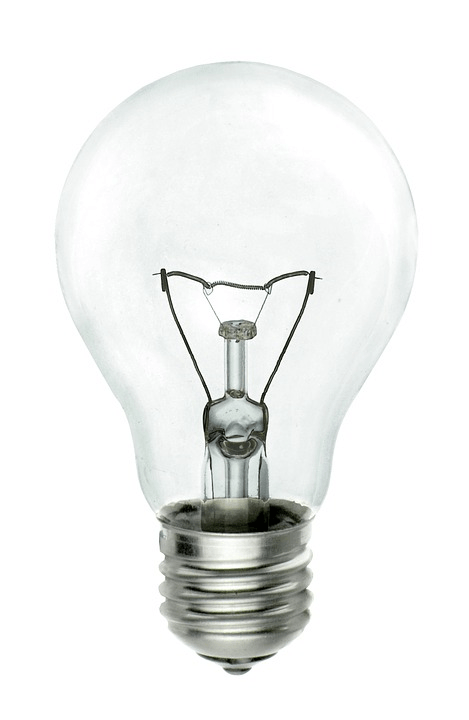Incandescent Lamps Information
 Incandescent lamps generate light by passing an electric current through a thin filament wire until the wire is white-hot. They are used mainly in residential applications because they emit a warmer light that contains less red and blue. Incandescent lamps include enclosures (bulbs) made from a ribbon of hot glass that is first thickened and then blown into molds. These glass enclosures are then cooled, cut from the ribbon, and coated with a finishing material. The filament is formed by drawing tungsten metal into a tightly coiled wire. The finished filament is then clamped or welded to leads which are embedded in a glass supporting structure. This structure is then inserted into the bulb and the parts are fused together. When most of the oxygen has been removed, the bulb opening is sealed and a base is attached.
Incandescent lamps generate light by passing an electric current through a thin filament wire until the wire is white-hot. They are used mainly in residential applications because they emit a warmer light that contains less red and blue. Incandescent lamps include enclosures (bulbs) made from a ribbon of hot glass that is first thickened and then blown into molds. These glass enclosures are then cooled, cut from the ribbon, and coated with a finishing material. The filament is formed by drawing tungsten metal into a tightly coiled wire. The finished filament is then clamped or welded to leads which are embedded in a glass supporting structure. This structure is then inserted into the bulb and the parts are fused together. When most of the oxygen has been removed, the bulb opening is sealed and a base is attached.
Types of Incandescent Lamps
Incandescent lamps use several types of lamp bases.
- Candelabras and intermediate bases are designed for decorative lighting applications.
- Miniature candelabras are used in flashlights and instrument panels, typically under 30 volts.
- Single-contact and double-contact candelabras use bayonet connections instead of screw connections as contacts.
- Medium and three-contact medium lamp bases, some of which are skirted or flared, are typically used in household lamps up to 300 watts and in some mercury and sodium lamps below 100 watts.
- Mogul, mogul end prong, and three-contact mogul bases are used in mercury, metal halide, and sodium lamps over 300 watts.
Lamps requiring more than 200 volts are more likely to have a mogul (or larger) base rather than a medium base. Incandescent lamps with a recessed single contact are also available.
Specifications
Important specifications to consider when searching for incandescent lamps include:
- Maximum overall length
- Light center length
- Life hours
- Watts
- Lumens
- Color temperature
Typically, maximum overall length is expressed in inches (in). Light center length is the distance between the center of the filament and the light center length reference plane. Lamp labeling rules from the U.S. Federal Trade Commission (FTC) define light output in lumens (lm), a standard unit of measure for the luminous flux or quality of light. Maximum overall length is usually expressed in inches. Mean lumens specify the average lamp output over a designated amount of time, usually 40% to 50% of the rated lamp life. Color temperature measures the visual "warmth" or "coolness" of the light from incandescent lamps. Higher values are associated with lights that are whiter in appearance.
Selecting incandescent bulbs also requires an analysis of filaments, most of which are made of tungsten. Filaments that begin with the letter "C" indicate that the wire was coiled once. Filaments that start with "CC" indicate that the wire was coiled twice. The letters or numbers that follow the "C" or "CC" indicate the position of the filament. C-filament designations include:
- C-1
- C-2R
- C-2V
- C-5
- C-7A
- C-8
- C-9
- C-11
- C-11V
- C-13
- C-13D
- C-17
- C-17A
- C-22
- C-130
CC-filament designations include:
- CC-2R
- CC-2V
- CC-6
- CC-8
- 2CC-8
- CC-11
- CC-13
Other filament configurations for incandescent lamps include BP, FF, M, MP, and SC.
Resources
Image credit:
Pixabay
- Alabama
- Arkansas
- Arizona
- California
- Colorado
- Connecticut
- District of Columbia
- Delaware
- Florida
- Georgia
- Iowa
- Illinois
- Indiana
- Kansas
- Kentucky
- Louisiana
- Massachusetts
- Maryland
- Michigan
- Minnesota
- Missouri
- North Carolina
- Nebraska
- New Hampshire
- New Jersey
- New York
- Ohio
- Pennsylvania
- Tennessee
- Texas
- Virginia
- Washington
- Wisconsin
- 2-Pin
- Bi-Pin T-5
- C-11
- C-11V
- C-13
- C-17
- C-17A
- C-2R
- C-2V
- C-5
- C-6
- C-7A
- C-8
- C-9
- CC-11
- CC-13
- CC-2V
- CC-6
- CC-8
- Candelabra
- Double Contact Bayonet
- Double Contact Bayonet Candelabra
- Intermediate
- Medium
- Medium Refocus
- Medium Skirted
- Miniature Bi-Pin
- Mogul
- Mogul End Prong
- Reflector
- Screw Terminals
- Single Contact Bayonet Candelabra
- Three Contact Medium
